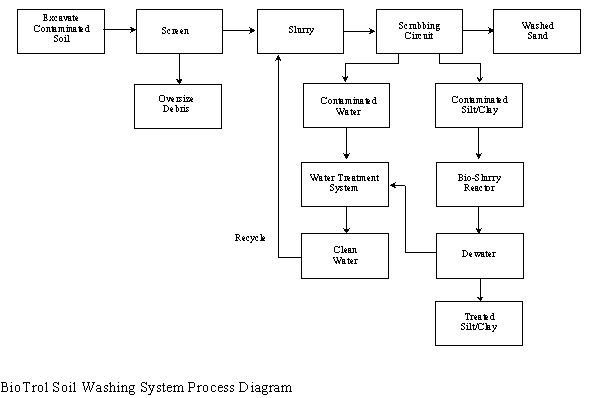
(Soil Washing System)
The BioTrol Soil Washing System is a patented, water-based volume reduction process used to treat excavated soil. The system may be applied to contaminants concentrated in the fine-sized soil fraction (silt, clay, and soil organic matter) or in the coarse soil fraction (sand and gravel).
In the first part of the process, debris is removed from the soil. The soil is then mixed with water and subjected to various unit operations common to the mineral processing industry (see figure below). The equipment used in these operations can include mixing trommels, pug mills, vibrating screens, froth flotation cells, attrition scrubbing machines, hydrocyclones, screw classifiers, and various dewatering apparatus.

The core of the process is a multistage, countercurrent, intensive scrubbing circuit with interstage classification. The scrubbing action disintegrates soil aggregates, freeing contaminated fine particles from the coarser material. In addition, surficial contamination is removed from the coarse fraction by the abrasive scouring action of the particles themselves. Contaminants may also be solubilized, as dictated by solubility characteristics or partition coefficients.
Contaminated residual products can be treated by other methods. Process water is normally recycled after biological or physical treatment. Contaminated fines may be disposed of off site, incinerated, stabilized, or biologically treated.
This system was initially developed to clean soils contaminated with wood preserving wastes, such as polynuclear aromatic hydrocarbons (PAH) and pentachlorophenol (PCP). The system may also apply to soils contaminated with petroleum hydrocarbons, pesticides, polychlorinated biphenyls, various industrial chemicals, and metals.
The BioTrol Soil Washing System was accepted into the SITE Demonstration Program in 1989. The system was demonstrated under the SITE Program between September and October 1989 at the MacGillis and Gibbs Superfund site in New Brighton, Minnesota. A pilot-scale unit with a treatment capacity of 500 pounds per hour operated 24 hours per day during the demonstration. Feed for the first phase of the demonstration (2 days) consisted of soil contaminated with 130 parts per million (ppm) PCP and 247 ppm total PAHs; feed for the second phase (7 days) consisted of soil containing 680 ppm PCP and 404 ppm total PAHs.
Contaminated process water was treated biologically in a fixed-film reactor and recycled. A portion of the contaminated soil fines was treated biologically in a three-stage, pilot-scale EIMCO Biolift reactor system supplied by the EIMCO Process Equipment Company. The Applications Analysis Report (EPA/540/A5-91/003) and the Technology Evaluation Report Volume I (EPA/540/5-91/003a) and Volume II (EPA/540/5-91/003b and EPA/540/5-91/003c) are available from EPA.
Key findings from the BioTrol demonstration are summarized below:
TECHNOLOGY DEVELOPER CONTACT:
Dennis Chilcote
BioTrol
10300 Valley View Road, Suite 107
Eden Prairie, MN 55344-3456
612-942-8032
Fax: 612-942-8526